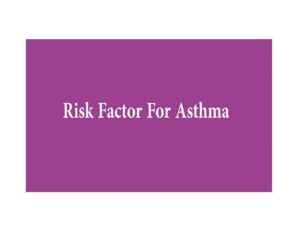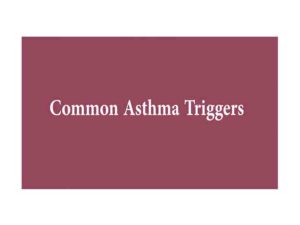Asthma Risk Factors
The exact cause of asthma Asthma is Unknown. Multiple factors are responsible for asthma.
Asthma may be due to complex interaction of multiple factors including a combination of environmental and genetic factors.
Triggering factors of Asthma
Exposure to various irritants, chemicals and substances can trigger asthma symptoms. These factors include:
- Airborne substances, such as pollen, dust mites, mold spores etc
- Respiratory infections, like RSV
- Cold air
- Physical activity (EIB)
- Air pollutants and irritants, such as smoke
- Medications, including beta blockers, aspirin, ibuprofen
- Strong emotions and stress
- preservatives added to some types of foods and beverages, including shrimp, dried fruit etc
- Gastroesophageal reflux disease
The following are the factors increases the increase incidence of asthma-
-
Genetic factor:
There are several genes identified which may be associated with increased risk of asthma. Family history of atopy or some form of allergic disease will increase the likelihood of allergy in child.
-
Allergic rhinitis:
Allergic rhinitis is a major risk factor for development of asthma. Children who has allergic rhinitis are at increased risk of asthma in later life.
-
Allergen sensitization and exposure:
Sensitization to the environmental allergen is strongly associated with the development of childhood asthma. However, allergen avoidance measure in already developed case of asthma is a debatable issue and is it advisable to avoid allergen whenever possible.
-
Smoking
Exposure to cigarette smoke is a major risk factor for wheezing illness in children. Maternal smoking during pregnancy significantly increases the risk of wheezing in early childhood. However, these factors may not increase the risk of atopic asthma later in life.
Phenotypes of Asthma:
Asthma may have cluster of characteristics that define the disease and its subsets. These subsets are asthma phenotypes. These include
• Allergic asthma:
Is the most common phenotype. This variety of asthma mainly occur in childhood. There may have a past and/or family history of allergic disorders like such as eczema, allergic rhinitis, or food allergy. This phenotype responded well with inhaled corticosteroid (ICS) treatment.
• Non-allergic asthma:
here the asthma not associated with allergy. These type of patient less responded to ICS.
-
Pre-asthma wheezing
These phenotypes mainly occur in infant and pre school children. It may be episodic due to virus or trigger by multiple factors.
• Late-onset asthma:
occur in adult, mainly in women. These types of asthma require higher dose of ICS.
-
Exercise-Induced Bronchospasm (EIB)
here the person experience asthma symptoms during exercise.
-
Aspirin-Exacerbated Respiratory Disease (AERD)
It consists of three clinical entities namely asthma, recurrent nasal polyp, and sensitivity to aspirin and other non-steroidal anti-inflammatory drugs (NSAIDs).
• Asthma associated with apparent irreversible airflow limitation:
Few patients with long-standing asthma develop fixed airflow limitation. Remodeling of the airways is responsible for this phenotype. .
• Asthma with obesity:
obese patients with asthma may have prominent respiratory symptoms




